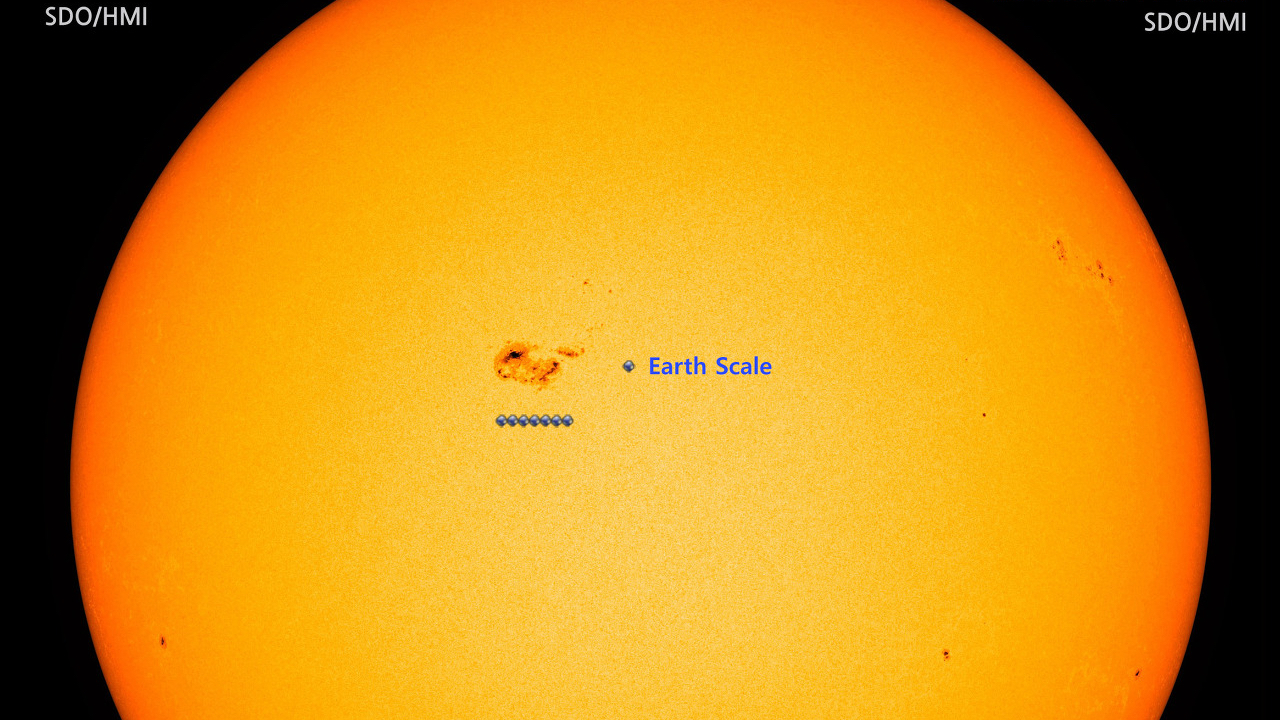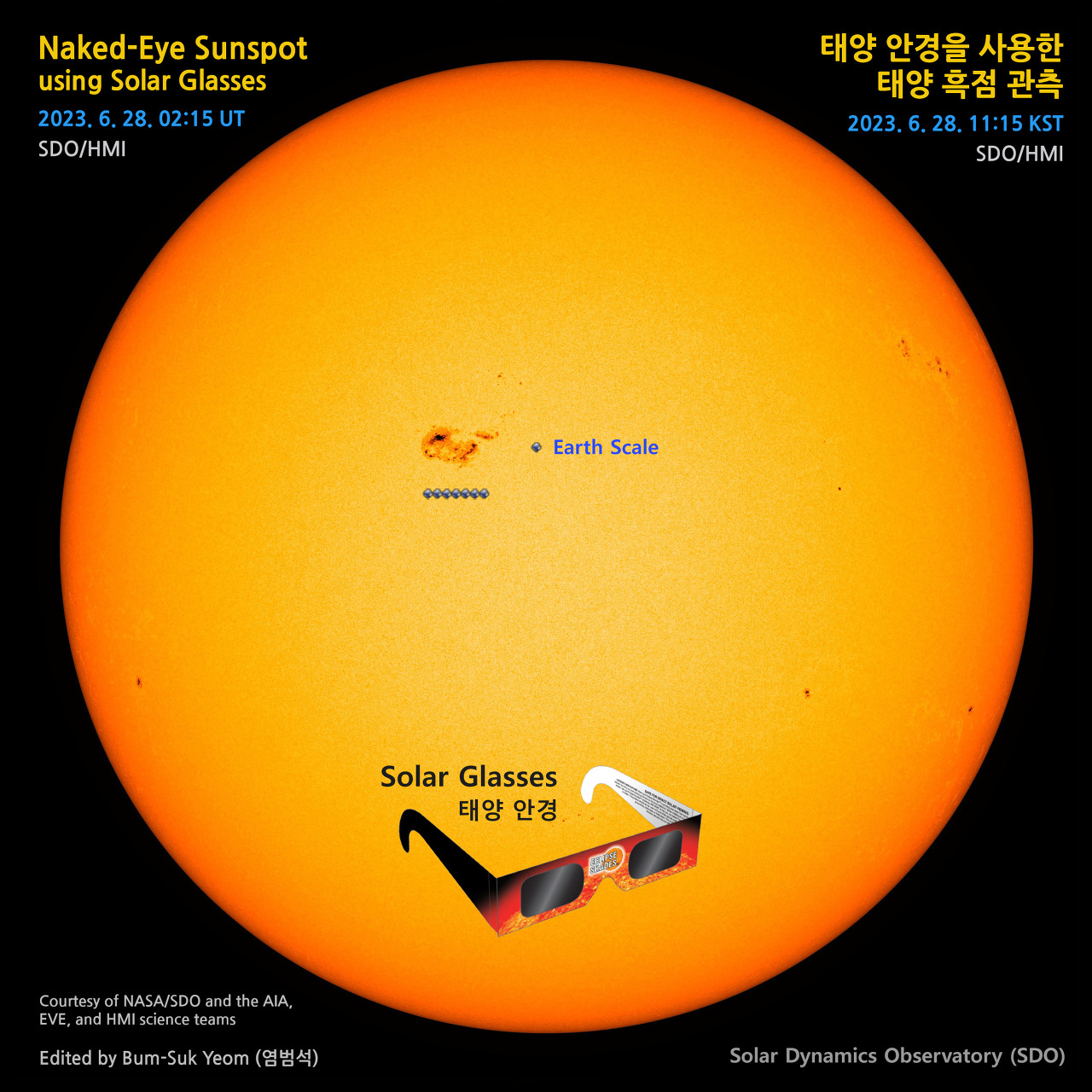You can see a huge sunspot 7 times wider than Earth right now — but be careful!
To catch the giant sunspot before it disappears on Sunday (July 2), ensure you wear solar glasses use solar filters.

A huge sunspot seven times wider than Earth is currently visible to the naked eye. But skywatchers should remember to protect their eyes when looking at the sun if they intend to glimpse the feature before it vanishes.
The tremendous dark spot on the sun, designated AR3354, will disappear on Sunday (July 2), rotating out of Earth's view. According to SpaceWeather.com, the sunspot just appeared on Monday (July 26), and it has grown a lot since.
On Twitter, solar physicist Keith Strong shared a stunning timelapse video of the sunspot as it crossed the face of the sun. Strong wrote: "The newly numbered sunspot region, AR3354, has been growing rapidly in the last 24 hours. Two days ago, it wasn’t even there, now it has spots larger than the Earth. If this rate of growth continues, we should start to see some big flares from it."
Related: Wow! Amazing video shows International Space Station crossing the sun during spacewalk
RAPIDLY GROWING SUNSPOT GROUP: The newly numbered sunspot region, AR3354, has been growing rapidly in the last 24 hours. Two days ago, it wasn't even there, now it has spots larger than the Earth. If this rate of growth continues, we should start to see some big flares from it. pic.twitter.com/fNTupeozftJune 27, 2023
As Strong implied, as well as growing in size, the sunspot has also grown in intensity. SpaceWeather.com added that AR3354 had developed a gamma magnetic field that could result in strong solar flares. The U.S. National Oceanic and Atmospheric Administration (NOAA) predicted a 40% chance of medium-sized, or M-class, solar flares as a result of AR3354 on Wednesday (July 28).
Following the solar flare forecast, Strong caught such an M-class flare in stunning detail as it erupted outward from AR3354, also sharing the footage on his Twitter account.
M FLARE! An M2 flare was just produced by sunspot region AR3340 near the NW limb. It looks very similar to the last 2 but now we are seeing it mostly from the side rather than from above. Still scant evidence of a coronal mass ejection being launched by it, no strong ejecta seen. pic.twitter.com/noS90WWzRJJune 28, 2023
NOAA forecasters added there is also a 10% chance of the largest class of solar flare, an X-flare, on Wednesday.
Get the Space.com Newsletter
Breaking space news, the latest updates on rocket launches, skywatching events and more!
The eruptions could affect Earth, as the sunspot is currently turning toward the planet. According to the European Space Agency (ESA), M-class flares can result in brief radio blackouts that affect Earth's polar regions and can trigger minor radiation storms. X-class flares, on the other hand, are major events that can lead to radio blackouts across the globe and long-lasting radiation storms in the upper atmosphere.
Sunspots are the result of strong magnetic field activity on the sun's surface, known as the photosphere. This can lead not just to flares but also to coronal mass ejections (CMEs), massive outflows of stellar material. At the time of writing, however, AR3354 hadn't yet blasted out a CME.

Though it is incredible in size, this new sunspot is unlikely to lead to activity as violent as the most intense solar storm on record, called the Carrington Event.
On Sept. 1, 1859, several sunspots, which were estimated to be collectively around the width of Jupiter, blasted out a CME that caused a bright white flash that lasted around five minutes and briefly blinded amateur astronomer Richard Carrington, who the event would later be named after.
Don't follow in the footsteps of Carrington and have your eyes damaged. If you intend to view the big sunspot, you should employ a pair of solar glasses, eclipse glasses or other type of certified eye protection. And before using such gear, you should check them for scratches. Put the glasses on before looking at the sun and look away before you remove them, as even brief exposure to the sun can damage your eyes permanently.
Additionally, dedicated solar binoculars are available with in-built solar filters that can be used to view the sun and get a magnified view of the solar disk. Our guide to safe solar observations should also be useful, and if you intend to photograph AR3354 or any other sunspot, we also have a guide to safely imaging the sun.
Join our Space Forums to keep talking space on the latest missions, night sky and more! And if you have a news tip, correction or comment, let us know at: community@space.com.

Robert Lea is a science journalist in the U.K. whose articles have been published in Physics World, New Scientist, Astronomy Magazine, All About Space, Newsweek and ZME Science. He also writes about science communication for Elsevier and the European Journal of Physics. Rob holds a bachelor of science degree in physics and astronomy from the U.K.’s Open University. Follow him on Twitter @sciencef1rst.
-
rod I did observe AR3354 today.Reply
Observed 1300-1400 EDT/1700-1800 UT. I observed sunspot active region AR3354 today using 90-mm refractor telescope with glass white light solar filter at 25X, TeleVue 40-mm plossl. This sunspot region easy to see covering nearly 3 arcminutes across. Spaceweather.com reported today: “GIANT SUNSPOT ALERT: When this week began, sunspot AR3354 didn't exist. Now it is 10 times wider than Earth and still growing. The sunspot burst into view on June 27th, breaching the surface of the sun, then blossoming into a giant over the next 48 hours: movie. AR3354 is so big, amateur astronomers can see details normally reserved for the world's greatest telescopes." At the Sun's distance ~ 1.017 AU (Stellarium 23.1), earth size diameter 17.3 arcsecond and my telescope view resolved ~ 12 arcsecond on the Sun. Multiple small and dark cores visible in AR3354. I viewed with passing cumulus, altocumulus, and smoke haze from Canada so not the best conditions. -
billslugg I observed the sunspot group for about 10 minutes around 1315 EDT. Celestron 25x100 binoculars, aluminized solar filters. Light scattered cumulus clouds. It is a huge group of spots. Twenty five power just not enough, needs to be around 100 power.Reply -
rod Reply
Very good billslugg. Glad you can view safely using those Celestron binoculars. Weather for me in MD was poor viewing with clouds moving by and smoke above :)billslugg said:I observed the sunspot group for about 10 minutes around 1315 EDT. Celestron 25x100 binoculars, aluminized solar filters. Light scattered cumulus clouds. It is a huge group of spots. Twenty five power just not enough, needs to be around 100 power.









